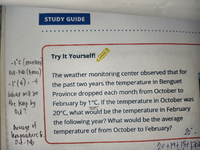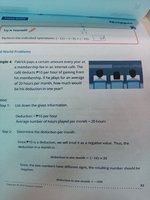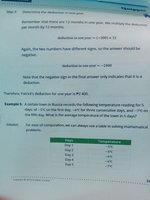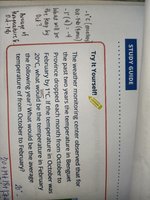Thanks. Showing both the actual assignment and an example is an excellent way to give us context.
It appears that you have in fact done some work, though you haven't directly answered our requests to show it. In the corner of the problem,

,
you wrote 20+19+18+17+..., which implies to me that you have successfully found the first four months' temperatures, at least, and are at least starting to find the average. You presumably made (or could make) a table like they do in Example 5, and use that for the average.
I think if you just show us the rest of your work, we will be able to either tell you that you are finished, or help you with one last step. This is not a difficult problem, and maybe you expect it to be harder! There is no need to write a particular equation, or to use PEMDAS; the most you need at any point is 20 - 1 = 19, or 20 + (-1) = 19. And since they asked for the temperature each month, you don't need to calculate, all at once, the temperature in February.
Like for example if you are going to write it in equation:
-1 (cue word is drop) then positive 4 for 4 months...
so -1 x (4) then aanswer is -4.
For the next question, what would be the temperature by February next year if October starts at 20 degrees C and it drops 1 degree celcius every month.
Then what is the average of the temperature from october to February.
Thank you very much for this group!
As for what they are teaching you, it looks like you are being introduced to the idea of negative numbers, so they are using them in places you don't really need to use them. You can either say that -1 is being
added each month, or that 1 is being
subtracted each month; these are the same thing, as I suggested before.
In the deduction example, I would rather have said that the total deduction is P2400, as they do at the end, rather than that the deduction is -2400, since the word "deduction" already tells you the direction; but the
change is -2400, where we need the sign to indicate the direction. But that's a matter of words more than math.





